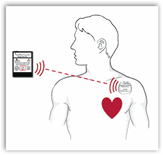The device is already in use in Europe and in Brazil. It looks like a pace maker  implant and monitors your system. The design is to obviously warn of attacks that would otherwise have no symptoms that would be immediately recognized. When an attack is recognized the device vibrates and communicates to an external device that looks like a pager that beeps and flashes.
implant and monitors your system. The design is to obviously warn of attacks that would otherwise have no symptoms that would be immediately recognized. When an attack is recognized the device vibrates and communicates to an external device that looks like a pager that beeps and flashes.
When you arrive at the hospital the doctor can retrieve the information via a computer to get the specifics on the attack and the idea here is also provide the best treatment with the use of the information provided. The AngelMed device is currently in clinical trials and available for those who have had a heart attack in the last 6 months and you can find out more at the website. California looks to have the largest number of locations thus far. It makes one wonder if not too far down the road if we will all have one of these? It does appear to require a specific computer work station PC to retrieve the information.
NEW State of the Art Medical Technology First of its kind heart monitor warns patients of impending Heart Attack/One That Is In Process-- Inventor Dr. Fischell Available
A first-of-its-kind investigational medical device designed to alert a patient that they are having a heart attack or are very close to having one is now in a Pivotal Study. The AngelMed Guardian System, an implantable cardiac monitor and alerting system, is designed to reduce the time it takes patients to get to the emergency room during an impending heart attack. The device is designed to continuously monitor the heart’s electrical system and provide a warning to go to the ER when critical ST segment changes occur…potentially even before they have heart attack symptoms.
More than a million heart attacks occur every year, and unfortunately, almost 1/3 of those are fatal. Many patients ignore or don’t recognize heart attack symptoms and don’t get to the hospital until three hours or more after symptoms occur. The medical community knows that “time is muscle.” And, there has been much effort made to decrease door to balloon time (the amount of time it takes a patient to get from the emergency room to having angioplasty or other treatment for an occluded artery). Unfortunately, there has been little decrease in mortality because patients continue to delay in seeking help or calling 911.


Tidak ada komentar:
Posting Komentar